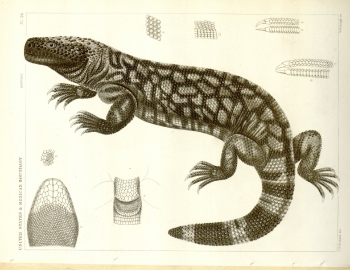Celebrating '20 Years of Discovery' at ASU’s Biodesign Institute

Graphic by Jason Drees/ASU
Editor’s note:The Biodesign Institute at Arizona State University continues to celebrate its landmark 20th anniversary with this fifth installment in its "20 Years of Discovery" series. Each installment explores key scientific breakthroughs and significant innovations achieved since the institute's inception in 2004.
The Biodesign Institute at Arizona State University is making significant impacts in modern evolutionary studies and human health, examining how new understandings of our biological diversity are enhancing approaches to health and disease.
Among the pioneering research being conducted at the institute are studies into biomarkers, which are vital for early diagnosis and personalized medical treatments, as well as research on the role of artificial intelligence in transforming numerous fields, including health care, by refining data analysis and predictive models. Together, these advances underscore the institute's commitment to harnessing the latest science to solve complex challenges and improve human well-being.
Evolution and health
Insights from the Gila monster genome
Biodesign scientists successfully sequenced the complete genome of the Gila monster, a venomous lizard indigenous to the Southwestern United States. This research unravels the unique composition of the lizard’s sex chromosomes, which sharply contrast with the conventional XX/XY system seen in most vertebrates.
The genomic analysis illuminates the processes of sex chromosome evolution, providing deeper insights into the adaptability of these lizards to their arid desert habitats. Such findings are crucial for understanding the ecological and biological mechanisms that support the Gila monster's survival under extreme environmental conditions.
"This crowdfunded Gila monster genome is evidence of what community-driven research can accomplish, opening up new research, and new possibilities to conserve such an incredibly beautiful creature," says ASU Professor Melissa Wilson, an evolutionary biologist who led the project.
Decoding the Gila monster's genome also significantly advances our knowledge of reptilian biology and evolutionary adaptations. This breakthrough has the potential to guide conservation strategies for the Gila monster and other species that inhabit similar challenging environments, ensuring their preservation amid changing global climates. (2024)
Exploring the origins of complex cells
Recent research is reshaping our understanding of how complex cells, known as eukaryotic cells, first evolved — a major turning point in the history of life on Earth.
Simple organisms like bacteria and archaea (prokaryotes) lack a nucleus and complex internal structures. Eukaryotic cells, which appeared around 2 billion years ago, have specialized compartments, including mitochondria and the endoplasmic reticulum, that enable more advanced functions.
For years, scientists believed that the evolution of mitochondria was key to this transition, as it allowed cells to grow larger and support more energy-demanding activities. However, new findings suggest that early cells might have become gradually more complex without mitochondria at first, challenging the idea that mitochondria were essential from the start. This opens fresh perspectives on one of life’s greatest evolutionary steps. (2022)
Transcription errors and neurodegenerative disease
New research at the Biodesign Institute explores how inaccuracies in the transcription process, where DNA is converted into RNA, result in the production of malfunctioning proteins. These faulty proteins are critical in the progression of neurodegenerative disorders, including Alzheimer’s disease, as they disrupt cellular functions and contribute to disease pathology.
The findings highlight a potential pathway for therapeutic intervention. By enhancing the fidelity of the DNA transcription process, it may be possible to prevent or mitigate the synthesis of these defective proteins, thereby impeding the progression of neurodegenerative conditions.
Such innovative treatments could halt or even reverse the debilitating effects of neurodegenerative disorders, providing hope for effective interventions that directly tackle the root causes of these diseases, which impact millions of individuals globally. This research offers insights into the molecular underpinnings of disease and underscores the importance of precise genetic transcription in maintaining cellular health and preventing disease. (2023)
Advances in biomarker research
Early diagnosis of oropharyngeal cancer
The growing incidence of oropharyngeal cancer, primarily linked to the human papillomavirus (HPV), has prompted significant advancements in biomarker research at ASU. With a new $4.8 million grant from the National Cancer Institute, ASU researchers are developing diagnostic biomarkers that can be detected in saliva and blood samples.
This research explores sophisticated screening methods for cancers that typically evade early detection, such as HPV-related oropharyngeal cancer, which is difficult to diagnose and treat early.
“These head and neck cancers are difficult to detect early. They are nestled in the tonsils and in the base of the tongue, so they are both hard to find and treatment can have significant side effects,” says Karen Anderson, a researcher with the Biodesign Virginia G. Piper Center for Personalized Diagnostics. “We have been working on diagnostic tests for early detection, learning from decades of work in cervical cancer.”
The primary aim of this research is to create a noninvasive, cost-effective screening method using saliva, making early detection accessible and reducing the need for invasive diagnostic procedures. This new approach could significantly improve cancer screening, which is crucial in increasing the survival rates for cancers that develop without obvious symptoms. (2023)
Extracellular vesicles: A powerful diagnostic tool
Using tiny particles called extracellular vesicles (EVs) to diagnose diseases is an exciting new area of research. EVs are released by cells and carry proteins and genetic material that reveal information about the cells they came from. This makes them promising tools for detecting diseases, especially cancer.
At the Biodesign Institute, researchers are exploring the potential of EVs to provide less invasive diagnostic options. This approach could transform early disease detection, offering rapid, real-time insights into a patient’s health without invasive procedures.
The study of EVs is advancing toward clinical application, promising to enhance medical diagnostics. By using these vesicles, physicians could detect diseases at earlier stages, potentially improving treatment outcomes and enhancing patient prognosis.
Assessing radiation threats
The Biodesign Institute is advancing research to develop a rapid diagnostic test that would measure the absorption of ionizing radiation following radiological or nuclear incidents.
Funded by a $9 million contract option, this initiative could lead to a total investment of $31.2 million by the Biomedical Advanced Research and Development Authority. The project harnesses the expertise of ASU and Thermo Fisher Scientific, employing advanced qPCR technology, a precise lab method to measure and analyze specific DNA or RNA sequences, to analyze gene expression for radiation exposure.
The project's goal is to develop an automated system that can quickly and efficiently handle large numbers of blood samples. Such a system is pivotal as no rapid, FDA-approved method currently exists for assessing radiation doses in large populations. This initiative highlights ASU's role in enhancing public safety and strengthens its position at the forefront of biomarker research and innovation. (2014)
Artificial intelligence and human health
Tracking fatigue with AI and human breath
Arizona State University, in collaboration with Texas A&M, is leading a revolutionary $4.8 million project that aims to use artificial intelligence to detect human fatigue through the analysis of breath.
This innovative study, funded by the Defense Advanced Research Projects Agency, explores how signs of sleep deprivation, physical fatigue and mental exhaustion are manifested through volatile organic compounds present in human breath.
By analyzing these biomarkers, ASU researchers aim to transform performance monitoring in high-stakes environments such as military operations and long-haul transportation, where precise assessment of fatigue is critical for safety and efficiency.
To achieve this, the scientists used advanced algorithms to analyze more than 3,000 breath samples, positioning the study as one of the most extensive of its kind. This substantial dataset will allow scientists to enhance AI models that can detect subtle changes in breath composition, predicting different states of fatigue with high accuracy. (2022)
“One powerful aspect of breath testing is that it is highly adaptable for people with physical or cognitive disabilities, whereas many of the current fatigue measures would not be suitable for everyone,” says Heather Bean with the Biodesign Center for Fundamental and Applied Microbiomics. “This has led to a new collaboration with the University of Calgary to explore the use of fatigue breath tests in children with neurodevelopmental disorders, and I am eager to continue exploring the use of breath testing as an adaptive technology for field and clinical measurements. ”
Advancing personalized medicine with AI
In a significant advance towards personalized health care, ASU has developed an AI-powered tool, called HLA-Inception, which analyzes interactions between immune-linked proteins and peptides.
This sophisticated AI tool quickly predicts individual immune responses to pathogens and cancers, potentially revolutionizing the way cancer is treated. HLA-Inception categorizes these proteins based on their peptide binding preferences, enabling the creation of highly targeted cancer therapies and vaccines.
The tool processes complex protein interaction data in mere seconds, a significant improvement over traditional methods that are time-consuming and imprecise. The advancement could significantly enhance the specificity and efficacy of immunotherapies. The technique offers new possibilities for the effective management and treatment of cancer, providing clinicians with a powerful new resource to tailor treatments to individual immunological profiles.
This leap in technology underscores a shift towards more precise and personalized medical interventions, marking a significant milestone in the fight against cancer. (2024)
Cyber evolution
At the Biodesign Center for Biocomputing, Security and Society, researchers are harnessing the power of evolutionary computation to address complex problems across various fields. Evolutionary computation is a technique inspired by biological evolution, employing mechanisms like mutation and natural selection within computational algorithms to solve intricate challenges. This method proves particularly effective in areas such as software development, robotics and strategic game theory.
The research employs Darwinian principles in a digital context, developing algorithms that can evolve solutions to adapt to new and changing environments. This approach also enhances the ability of artificial intelligence to develop novel solutions that traditional algorithms might miss.
By applying evolutionary theory to computing, the researchers are broadening the scope of artificial intelligence, enabling it to tackle real-world problems marked by complexity and constant change, significantly advancing the field of digital system design.
More Science and technology

Lucy's lasting legacy: Donald Johanson reflects on the discovery of a lifetime
Fifty years ago, in the dusty hills of Hadar, Ethiopia, a young paleoanthropologist, Donald Johanson, discovered what would become one of the most famous fossil skeletons of our lifetime — the 3.2…

ASU and Deca Technologies selected to lead $100M SHIELD USA project to strengthen U.S. semiconductor packaging capabilities
The National Institute of Standards and Technology — part of the U.S. Department of Commerce — announced today that it plans to award as much as $100 million to Arizona State University and Deca…

From food crops to cancer clinics: Lessons in extermination resistance
Just as crop-devouring insects evolve to resist pesticides, cancer cells can increase their lethality by developing resistance to treatment. In fact, most deaths from cancer are caused by the…


